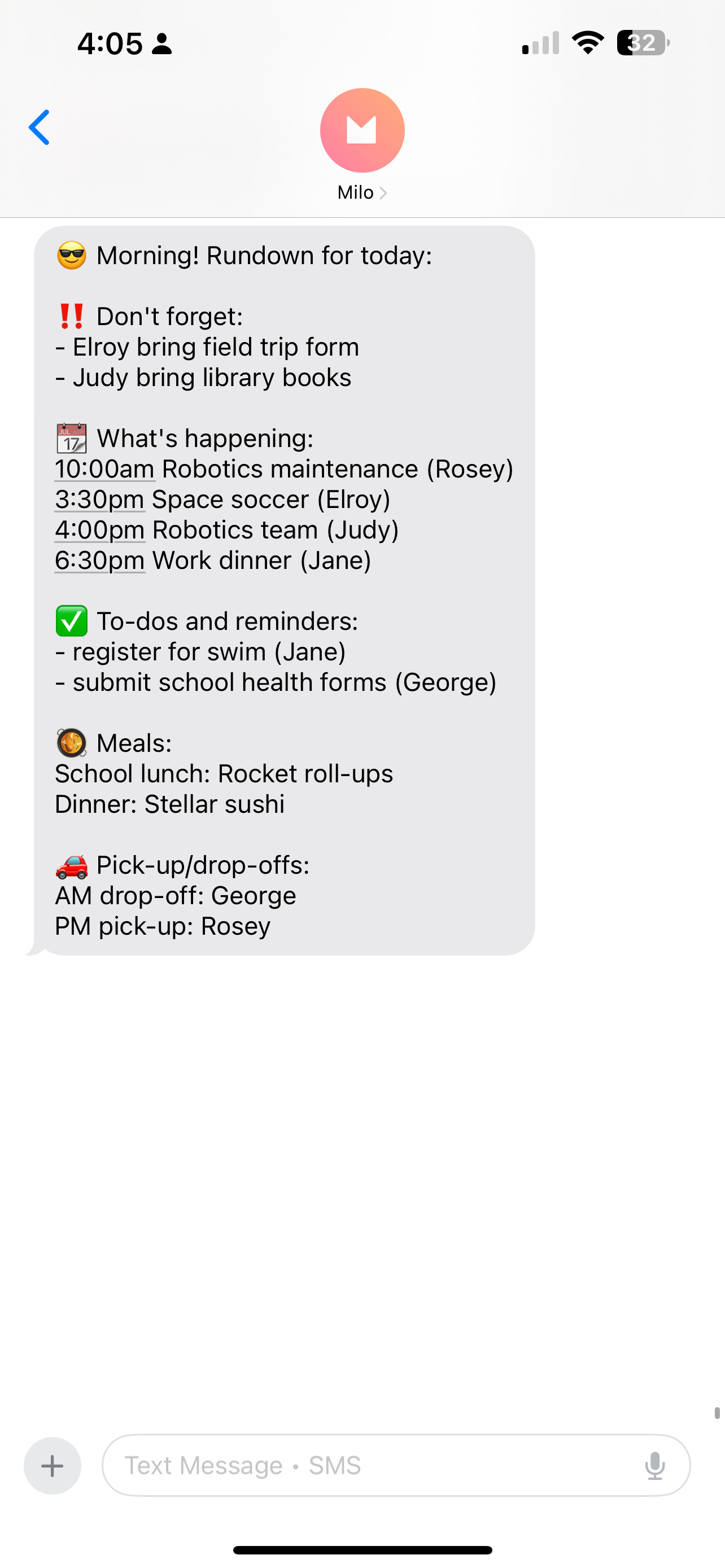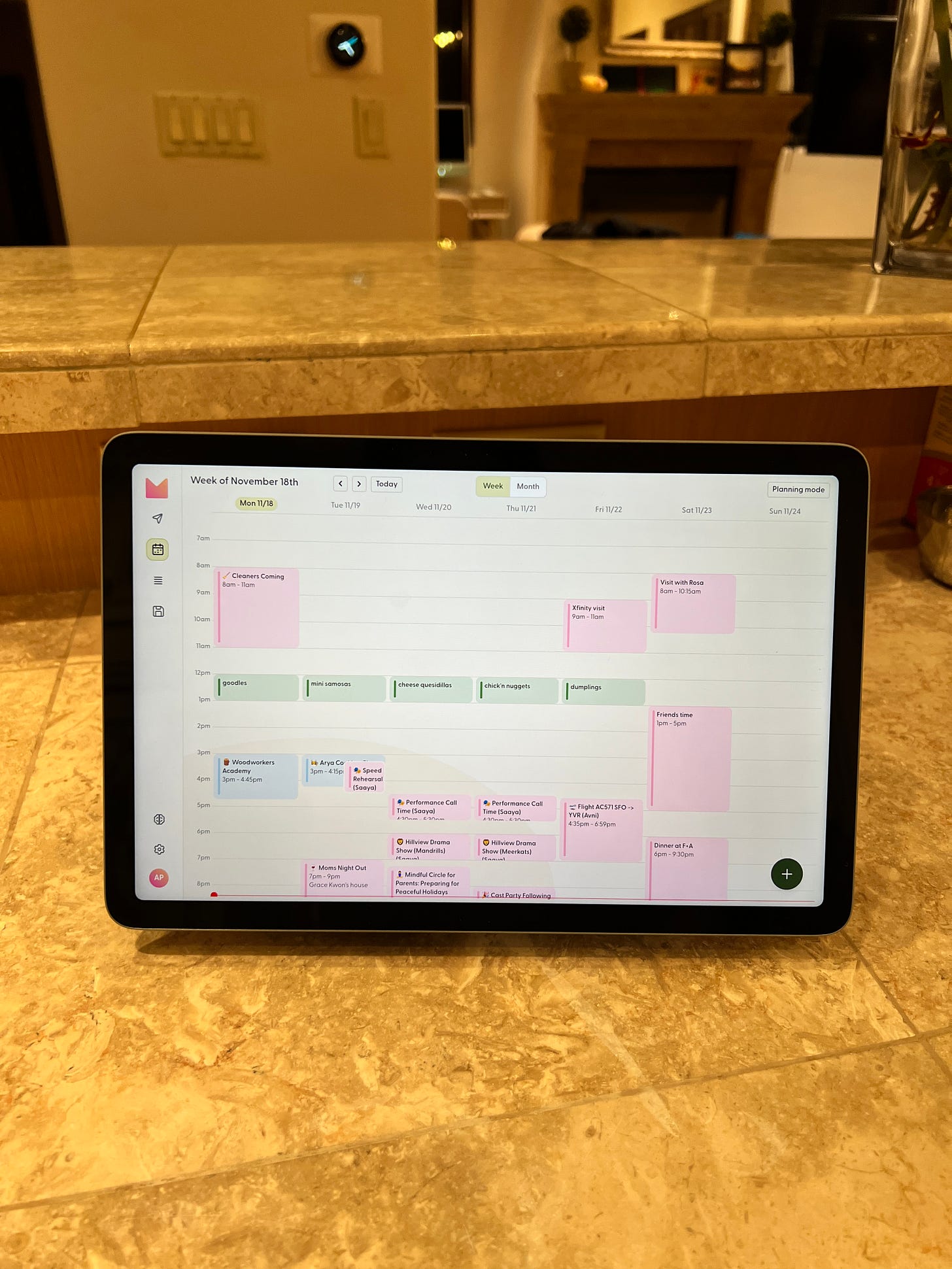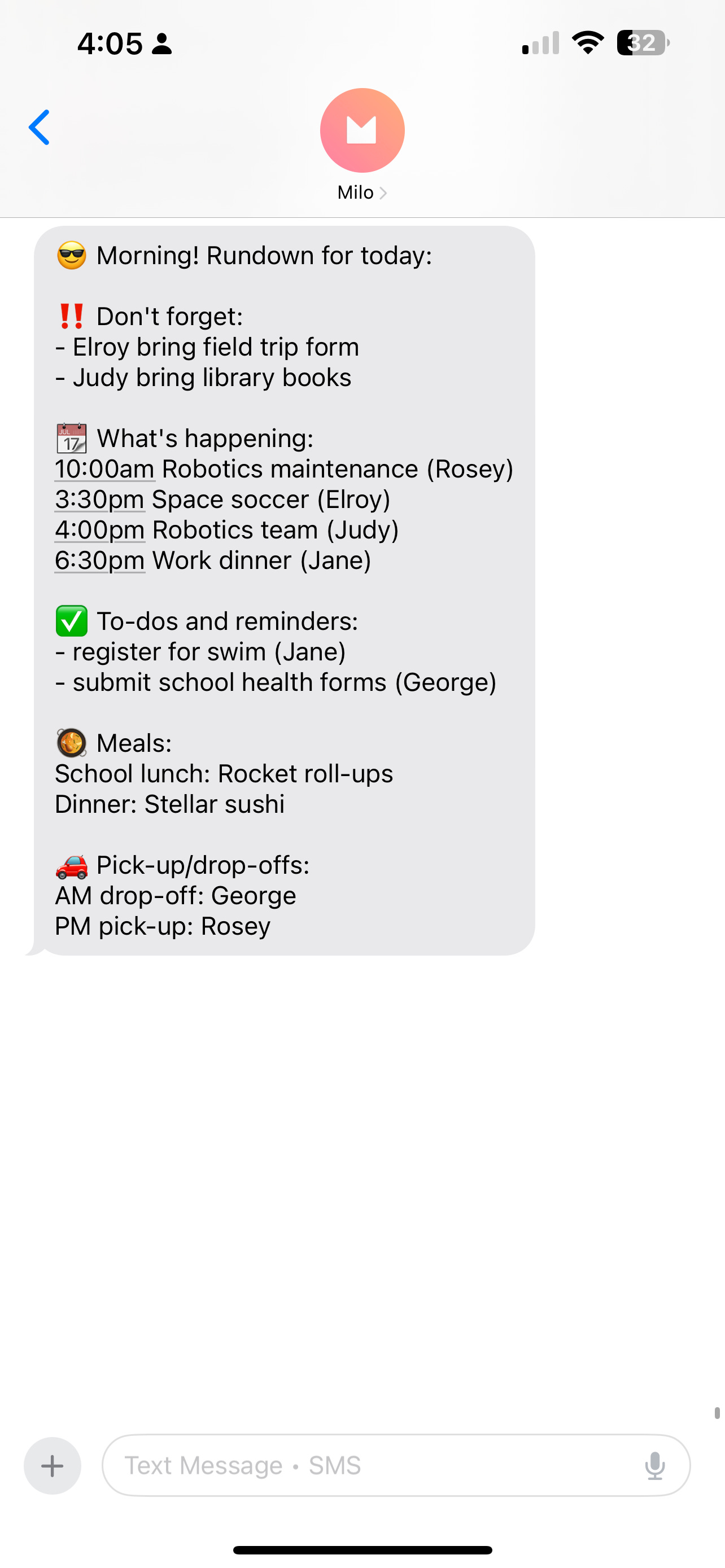Back to school is approaching (or is here 🫠) faster than any of us want to admit. But it’s the perfect time to set up a new system for the family with the new schedule and routines.
And after six years of working with thousands of families across the country, I wanted to pull together every best practice I’ve learned for setting up a successful (but simple) “family operating system”. Whether you want a super lightweight frame or an all-out system, we’ve got you covered.
(And, if you find this approach resonating but would like help actually doing it, I’d love for you to give Milo a try).
Let’s do this 💪🏽.
-avni
(Oh, and a favour? We’ve started sharing more insights and best practices on Instagram and TikTok if you could give them a follow 🙏🏽)
😅 The tl;dr
Biggest way raising kids has changed in the past 15 years is rise of the “modern invisible load” due to the shift to the digital age → more instant information, endless choice and the rise of outsourcing culture.
Our human brains were never meant to keep up with the speed and volume of digital info. So we need an effective filtering system built specifically to process and organize all that info into ways our brains can actually process.
There are many ways to build a system but they all need 3 things:
1. a central place to hold all the info (to make it accessible to all)
2. a way to get that info in and out to the people easily
3. a process (or ritual) to check-in and do the work each week
👉🏽 Without this, I deeply believe it is not possible to collaborate effectively, stay on top of things and not burnout.
👋🏽 Intro - why do I even need a “system”?
Modern parenthood feels different because it is different. If you’ve had a kid within the past 15 years, your experience is materially different than any parent before, specifically in one area: managing and coordinating how the family operates each week.
😓 The modern invisible load is a real thing. What the family does each week both individually (work/school) and as a family is more complex. So it all converges at the family calendar, not only covering events like appts or bdays, but also the work that gets done FOR the family (outsourcing/helpers).
- 👯♀️ dual income: more families have both parents working outside of the home (or single parent households).
- 📲 more outsourcing: that means less time, which is being solved by “throwing money at the problem”, or outsourcing to apps and services (Instacart, Doordash, cleaners, tutors etc) - this means less execution time but WAY more invisible planning and coordination time
- 👩🏽💻 endless choice + information: digital ages puts all info at our fingertips but for parents where there’s just so much to stay on top of it feels endless and overwhelming. Choices for kids learning and activities have also exploded which also makes schedules harder to manage.
- ⚡️ instant expectations and scheduled everything: digital age also means 5 school apps, 3 sports ones and everything being done with tickets and registration… very little can be left to spontaneity plus there’s an expectation to respond to everything instantly (forms, registrations, messages).
Our human brains were never meant to keep up with the speed and volume of digital info. So we need systems built specifically for this - a “filter” that can filter and organize all that info into ways our brains can actually ingest and process.📆 The family calendar needs to be the center of the system. Modern realities mean there is just too much to store in one mind. AND: if it’s going to be shared, it needs to not live in one person’s brain or inbox. So there needs to be a dedicated place that can hold all things family (so no running off of personal calendars and sending invites - it becomes untenable after kids start school).
While it doesn’t have to be digital (eg paper planners/whiteboards) if there are multiple people in the mix, I’d strongly recommend making it digital.
And lastly, having a dedicated family calendar allows for all of the different kind of events to be explicitly outlined (without that, we’re holding “implicit” (or implied) things - another way of keeping it invisible).🙅🏽♀️ The keeper of the calendar can’t be outsourced and it can’t be shared. What makes today’s invisible load so hard to share is that even if other home duties are divvied up, the Calendar Keeper role touches so many of the other tasks and so needs to be “kept in the loop”. Worse, it’s not possible to share the Calendar Keeper role (nor is it meant to be - for FairPlay users, it’s one card). This means one person has to be the point person at any given time. And while it’s possible to trade who “holds” the card at any given time, that’s only possible if there’s a way to hand-off the info and details easily.
⏰ You need to set aside actual time each week for the work of your family. One of the most obvious and easy places for improvement I’ve found is that we need to actually set aside time each week to batch do the work/have the conversations. Too many of us try to do it in the gaps between other things which has the dual problem of making us feel like there’s always something to do and never actually giving the work the best shot at getting done. This is also the time we can set “default decisions” for the week - consider all the info and identify what the default is for any given thing (meals, pickup/drop-offs), which allows for changes/spontaneity, but if you’re running behind, you can default to a well thought out decision.
The time can be split into two - one mid-week to work through tasks and one on the weekend to review and prep for the week ahead or it can all be done together but we can’t have all this work, and miraculously expect it to get done without protecting time to work on it.🍵 Priorities don’t run with schedules, but with rituals. The sad irony of modern life is that the most meaningful things to each of us (things like date nights or calling grandparents, walks with friends or a family bike ride) often don’t happen in the week because they get crowded out by everything else on the schedule. And it somehow feels like death to have to schedule these things.
But the truth is, we can still create boundaries that protect our priorities by thinking of them as rituals, not more things on the schedule.
🤓 The 101 of a Family Operating System:
Every good system has three core components:
🗃️ Central holding place for all of the information. This includes events/reminders, to-dos and other task lists (groceries, shopping etc) and information lists (school phone numbers, go-to meal recipes, dentist name etc).
📥 A way to get info in and a way to get it out:
a) 📩 Process for handling “incoming”. To minimize interruptions during the day, have a shared “inbox” to direct everything to (school emails, bday party invites, playdate requests, appt scheduling etc) and then set aside a time each night to clear that out and get the info to where it needs to go.b) 📝 Daily rundowns to keep everyone on the same page. Have an established format for the key information everyone needs to know. I’ve shared a starter template below. It typically includes:
- Critical reminders (bring diapers to daycare/bring library books/pajama day)
- What’s happening today - list of the day’s events
- To-dos/reminders - anything needing to get done
- Meals - the default decisions for school lunches, snacks and/or dinner
- Pick-up/drop-offs - default decision for who’s on for doing drop-offs and pick-ups each day
Milo uses simple SMS to share rundowns to everyone:c) 🖥️ In-home display. This one is optional, but as the kids get older and it’s helpful to have shared visibility on what’s going on and who needs to do what (eg chores or reminders), it’s helpful to have a visual representation in the kitchen. This could be a simple whiteboard or a tablet with the digital calendar on it.
Milo families load up the calendar on a screen - with color coding to show the different kinds of events/work: pink are the “one-offs”, blue are the weekly reoccuring, green are meals, purple is family priorities.👯♀️A ritual each week to collaborate, check- in and get things done.
It can be as little as an hour/week but protected time to review the week, pick the tasks to get done and talk through the tricky bits.
a) 👯♀️ Agreed upon “rules of engagement”. It starts with a conversation on how you’re choosing to manage your family. It’s probably one of the hardest parts of the whole thing because it involves having hard conversations with your partner and other collaborators to work through things like weekly check-in times and division of tasks and accountability/update processes. This step requires shared agreement from all parties on the process being used, how things are getting divvied up, and importantly? Accountability. Agreement and commitment to this process for the set period and then regular check-ins to adjust (I’d recommend quarterly).b) Mid-week and Sunday check-ins: I’d say the bare minimum is to have 2 blocks of time set aside each week. 30 min mid-week to work through tasks and 30min on Sunday to update on tasks, preview the week ahead and talk through any default decisions and tricky spots.
I’ve shared a template (and a script) to use for the Sunday weekly preview, but it follows the same format at the daily rundown and should be filled out with the “default decisions”. This allows you to make batch decisions with all of the info and still gives you the chance to make a spontaneous change but otherwise, you have a fall-back.
Here are 3 examples of how default decisions can help:
- default meals - just listing out what school lunches or dinners will be (especially for weekdays) allows you to avoid the 5pm frustration of deciding in the moment and allows someone else to get started on dinner or do lunches.
- default parent - assign a parent by week or day to be the “point parent” so that if (when) something inevitably goes sideways, that’s the person on call to deal with it.
- default nights - decide 1-2 set nights a week where each partner is assigned to have a later night - they can use it to work late, catch up with friends, have a workout, or come home early. But it’s protected time that doesn’t need to be negotiated each week. This has been game changing for my family.
For the weekly previews include any tricky spots for the week, and importantly? Who the point parent is each day if it’s being traded off, so there’s no question of who’s the go-to in the inevitable event of something going sideways.
There’s definitely more you can expand to but if we’re talking the bare minimum, every successful family system has some version of the above.
🧐 The Options:
Next week we’ll be diving deeper into the different options and who each is best for but a sneak peek:
✏️ Basic (using the base tools for simpler set-ups):
📆 Shared family calendar - Google calendar is the most popular but can use iCal or any other that works for you. You create an additional calendar and invite other family members/caregivers. They can load it up next to work calendars and turn on notifications if they need. There is also an agenda mode to email you everything going on.
📝 Shared lists - Google doc or Apple notes with the core lists: to-do, groceries, to-buy, to-discuss
😎 Sunday check-in with plan emailed to all - quick 15 minute review
👯♀️ Collaboration (planning to optimize with many people in the mix):
📆 Shared family calendar + lists (like above)
💬 Daily rundowns
😎 Check-ins: Sunday + mid-week
🏡 Values-based management (planning centered around core family values):
📆 Shared family calendar + lists (like above)
💬 Daily rundowns (like above)
😎 Check-ins: Sunday + mid-week (like above)+ quarterly family meetings
💕 Identify core family values to use as a filter/lens on weekly decisions - how to spend time to purchase decisions
🧰 The Toolbox:
💬 Daily rundown template - use this template to create quick rundowns to send via SMS or email (or throw into a shared Apple note)
📆 Week preview template - use this template in Apple Notes or Google Doc and send to everyone to review by Sunday night
🗣️ Script for weekly check-ins - use this guide to fill out the weekly check-in (the first one will likely take longer but most shouldn’t take more than 20 min after you have the hang of it).
👉🏽 A final note: the whole goal is for your family to find a system that works for you. What it looks like and what tools it uses matters so much less than it feeling good and sustainable for your needs.
If it works, you do you.
📚 Worth Reading:
🏡 Crafting your Family’s Culture - we’ll be updating this guide in the coming weeks, but this guide and this one can walk you through how to think about identifying your family’s core values and how to put them to work in the everyday.
💕 How will you measure your life - What can easily be lost in the focus on systems and calendars is why we’re doing any of this. It’s because we all want to be able to show up and be the parents and partners and people we want to be. Which means starting with our values and our intentions.
I was fortunate to have Clayton Christensen as a professor and while his teachings on disruption theory are legendary, it was this lecture on how to apply those principles to our home lives that stays with me. It has guided how we build Milo because at every point we want to focus on our Most Important Loved Ones.🎴 Fair Play - a card based approach to having a conversation around the division of labor in the home. And even more importantly? How to define the full nature of the task - from anticipation, to planning to execution - and the “minimal standard of care”, or the shared definition of how a certain thing gets done in your home, no matter who does it (eg. host gifts or school lunches or Tues night dinner)
Milo was built with these best practices in mind and focuses on doing 3 things exceedingly well.
🖥️ Creates one simple central place - family Gcal + shared lists (you can also use your existing Gcal)


✨ Processes all the things for you (especially getting it automatically added to the calendar)


Keeps everyone in the loop effortlessly, without needing to check another app.








